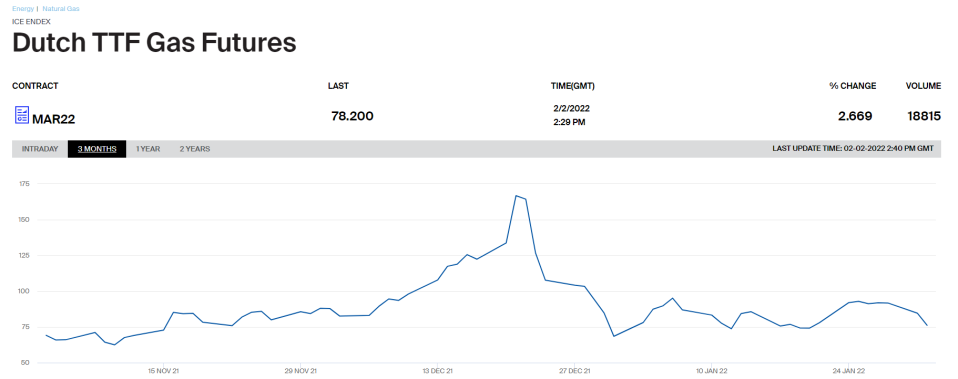Gas prices rise amid Yamal-Europe pipeline turbulence and Ukraine tensions

Gas prices have recovered from a mini-slump this month after flows in the Yamal-Europe pipeline were halted in both directions.
UK Natural Gas prices have risen to 3.3 per cent to £1.87 per therm, after weeks of stagnation, while the Dutch TTF Futures benchmark has enjoyed a similar three per cent bump to €78.50 per megawatt hour.
Prices spiked after data from German network operator Gascade showed that flows on the Yamal-Europe pipeline were suspended.
Flows had moved eastwards towards Russia since December 21, piling further pressure on European supplies.
While flows have now stopped moving away from Europe, the pause has dashed last night’s hopes of more exports into the continent.
Gazprom booked transit capacity for eight hours on Tuesday evening, and the pipeline even recorded an hour of western flows, before coming to a standstill in both directions.

The route provides one-sixth of Russia’s gas supplies into Europe and Turkey, and has come under increased media scrutiny and persistent tensions between the Kremlin and the West over the future of Ukraine.
Since the start of the year, over 100,000 Russian troops have massed near the border of traditional gas transit nation Ukraine, raising fears of an invasion.
The International Energy Agency has previously accused Russia of deliberately withholding gas to help to drive prices to record levels and put pressure on Europe to approve the Nord Stream 2 pipeline, which would double its exports into Germany and minimise Ukraine’s role in the energy network.
Russian President Vladimir Putin dismissed accusations last year as ‘politically motivated blather’.
Moscow is still waiting for Germany’s regulators to approve the link, while the EU has now paused its own separate approval process for the pipeline amid compliance concerns.
Prices recover from January’s slump as EU manages energy crisis
Gas markets dipped last month after reaching record levels in December, with prices soaring to over £4 per therm in the run-up to Christmas.
The US has been boosting the trading bloc’s liquified natural gas (LNG) supplies, while the continent further benefitted from a revival in renewables amid windier weather.
Ron Smith, BCS Global Markets told City A.M. the weather has been ‘very co-operative’ over recent weeks, with both wind and unseasonal patches of warmth driving down gas demand.
He said: “In January, Europe had some above average winds and above average temperatures. While the temperatures are more important than the winds they both play an effect these days.”
The continent has been the top destination for US supplies for two months running, according to the latest reports from Refinitiv.
About two-thirds of U.S. LNG volumes went to Europe last month, compared to 61 per cent in December, while the EU’s facilities for LNG conversion have risen from 51 per cent to 75 per cent of capacity over the past month.
Henri Patricot, equity research director at UBS, was optimistic that Europe had managed the worst of the gas market turbulence this winter.
He said: “Inventory levels are still much lower than usual but the gap versus average has not widened. We are of course gradually getting closer to the end of the winter so the risk of an extreme scenario for gas storage diminished.”
Nevertheless, the latest reports about the EU’s energy reliance on Russia are fairly definitive, meaning that macro-factors such as rising geopolitical tensions remain a potential factor.
Bruegel believes the EU would only be able to temporarily cope without Russia supplies, while Stifel has warned that the UK’s wholesale prices could quadruple if Russian flows were disrupted by sanctions or conflict in the region.